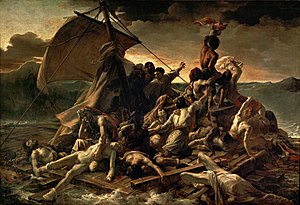The raft of the Medusa

|
| The raft of the Medusa |
|---|
| Théodore Géricault , 1819 |
| Oil on canvas |
| 491 × 716 cm |
| Louvre |
The raft of the Medusa ( French Le Radeau de la Méduse ) is a painting by the French romantic Théodore Géricault (1791-1824). He created the picture in oil on canvas in 1819 . The large-format picture, measuring 4.91 × 7.16 meters, is now hanging in the Louvre in Paris .
background
When Géricault submitted the painting to the Paris Salon for exhibition in 1819 , he was well aware of the public provocation caused by the motif and therefore it was no coincidence that he chose the harmless title Scene of a Shipwreck . No sooner had it been presented to the public than the exhibitors and salon visitors realized that with this image Géricault would leave France an unpleasant legacy: the memory of a scandalous incident in 1816 that led to the dismissal of the minister responsible for the navy and of 200 naval officers and which the French contemporaries would have preferred to forget.
In 1816 England returned the West African colony of Senegal, which had been occupied during the Napoleonic Wars , to France . This was the reason for the French government to send four frigates and infantrymen to Africa to protect their overseas property, as well as administrative officials and researchers. The frigate Méduse belonged to this convoy. Among the approximately 400 people on board the ship was the new governor of Senegal, the royalist Julien-Desiré Schmaltz . The Medusa was under the command of the captain Hugues Duroy de Chaumareys , who, after fleeing from Napoleon, had made his career not at sea but for 25 years in emigrant salons in Koblenz and London.
After the ship ran aground and the release failed, Captain de Chaumareys ordered the construction of a raft from the masts and yards of the Medusa, as there were only six boats for the 400 people on board. The raft with the considerable dimensions of 8 × 15 meters had to take 149 people. The boats should pull the raft ashore. After a short time the ropes were cut. Cannibalism quickly broke out on the raft , so that only 15 people could be rescued, but five more died.
The picture
Géricault had prepared himself well for the picture: he studied the texture and color of corpses, sketched numerous scenes in advance - a. a. a cannibalism scene, which he rejected again - and spoke in detail with the doctor Savigny, whom he portrayed in the picture (it is the bearded man to the left of the mast). Despite the real background, the painting is an expression of great artistic freedom. Géricault merely suggests in the left area of the picture that the raft was considerably larger. It can also be assumed that the surviving officers and infantrymen were in uniform and that the castaways were emaciated after 13 days of starvation. The astonishingly muscular human corpses pile up in the picture to form a pyramid. The stormy seas and the threatening clouds also do not correspond to the conditions at that time. That the desperate were exposed to the glow of the sun did not seem to Géricault a sufficient expression for the helplessness and the fear of death of the castaways. Even the flaring sail might not have been present in this form. The crew of the Argus reported that when they sighted the raft they initially assumed that the rags attached to the mast and ropes were the remains of a sail or laundry, in fact it was human flesh cut into pieces that had been hung up to dry .
The body hanging in the water at the bottom right was added by Géricault shortly before the public presentation for compositional reasons in order to create the pyramid shape of the bodies. For this reason, the inserted torso is significantly larger in relation to the other bodies. The exhibition of the picture did not bring the artist the immediate recognition he had hoped for - a subjectively perceived defeat from which he did not recover throughout his life. Today the painting is considered a great masterpiece of French painting. It is "part of the French self-image like the Mona Lisa or the Eiffel Tower."
Further works on the topic
From 1940 to 1943 Georg Kaiser wrote a play entitled The Raft of Medusa .
In 1967 Albert Uderzo and René Goscinny parodied the picture in their Asterix band Asterix as a legionnaire . The raft is occupied here with the pirates who keep appearing as a running gag and who were previously sunk by the Gauls. In an original French-language edition, the captain also says “Je suis médusé”, which literally only means “I am petrified”.
In 1968, the composer Hans Werner Henze wrote a scenic oratorio entitled Das Raft der Medusa , which premiered in Hamburg because the West Berlin performers were not prepared to make music under the portrait of Che Guevara and a revolutionary flag.
In 1969 the writer Vercors published the novel The Raft of Medusa. In the novel itself, the thematic relationship between its content and the painting is presented. There, too, it is about the French society of the interwar period.
In his novel The Aesthetics of Resistance , published in 1975, Peter Weiss reflects on the history of many other works of art, the style and intention of the image and its reception history.
In 1980, in what was then Yugoslavia, the feature film Splav meduze (German: The raft of Medusa) by Karpo Aćimović Godina was made about a group of eccentric, anarchist-Dadaist artists who were stranded in a Serbian village in the 1920s.
In 1985 the work was used by the Pogues as a template for the cover of their album Rum, Sodomy & The Lash . The faces of the band members were incorporated into the picture.
In his novel A History of the World in 10½ Chapters , published in 1989, the British writer Julian Barnes dedicates the fifth chapter, Shipwreck , to the image and its history.
In the early 1990s, sculptor John Connell recreated The Raft of Medusa in his project around the raft, a joint project with painter Eugene Newmann . He made life-size sculptures out of wood, paper and tar, which he placed on the large wooden raft.
In 1998, the film Le radeau de la Méduse by Iradj Azimi , which examines the origins and backstory of the image, in the French cinema. The main roles were played by Jean Yanne (as Chaumareys), Philippe Laudenbach (as Julien Schmaltz), Claude Jade (as Reine Schmaltz), Alain Macé (as Savigny) and Laurent Terzieff (as Géricault).
In 2004 Günter Seuren published his novel The Raft of Medusa . In it he describes the state of emergency on the hopeless raft and shows the parallels between this disastrous situation and the world of today.
The play Windstrich by the German playwright Walter Weyers , which premiered in 2008, relates directly to both painting and event.
A section of the work serves as the cover of the 2009 album The Divinity Of Oceans by the German funeral doom metal band Ahab .
In 2012, the psychologist and author Wolfgang Schmidbauer published a non-fiction book entitled Das Raft der Medusa about the current accumulation of crises, the danger of not recognizing their extent in time, and about possible ways out of a possibly looming disaster.
In 2014 Henning Mankell (1948–2015) dedicated his last book Quicksand in Chapter 20 (The Raft of Death) to the image and its historical background.
In 2015, Banksy quotes the motif in a stencil in Calais : Modern refugees can now be seen on the raft, in the background instead of the Argus a modern yacht with a helicopter. At this point in time, there is an illegal refugee camp near the city . On his website, Banksy comments on his work with "We're not all in the same boat".
In 2016, the webcomic SMBC cited the raft as the extreme of a sinister morality.
In 2017, the novel The Raft of Medusa by the writer Franzobel was published , which, however, deals with a shipwreck with a ship of this name.
literature
- Rose-Marie Hagen, Rainer Hagen: Masterpieces in detail. From the Bayeux Tapestry to Diego Rivera. Taschen, Köln 2000, ISBN 3-8228-4787-9 (see Vol. 2).
- Jean-Baptiste H. Savigny, Alexandre Corréard (surviving cartographer): The shipwreck of the frigate Medusa. Matthes & Seitz, Berlin 2005, ISBN 3-88221-857-6 (with a comment by Johannes Zeilinger and an essay by Jörg Trempler).
- Julian Barnes : A History of the World in 10½ Chapters. Rowohlt, Reinbek 2000, ISBN 3-499-22134-9 (see Chapter 5: analytical essay on Théodore Géricault's raft of the Medusa; original edition: A history of the world in 10½ chapters. Cape, London 1989, ISBN 0-224-02669 -0 ).
- Franzobel : The raft of Medusa , Vienna: Zsolnay Verlag 2017.
Web links
- Video guide for the painting at the artinspector
- Le Radeau de la Méduse in the Louvre
- Film Le Radeau de la Méduse in the Internet Movie Database (in English)

